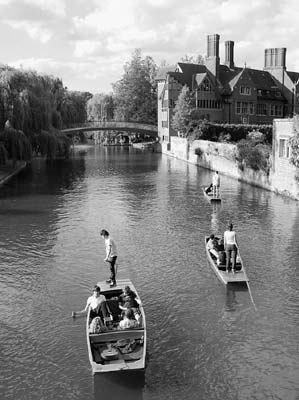
Windsor • Cambridge • Stonehenge
Windsor, Cambridge, and Stonehenge are three great day-trip possibilities near London. Any one of these very different but equally enjoyable destinations makes for an entertaining visit from London.
The primary residence of Her Majesty the Queen, Windsor hosts a castle that’s regally lived-in, yet open to the public. This is simply a charming town to relax in—and its proximity to Heathrow Airport (60 minutes by train west of London) makes Windsor easy to combine with a flight into or out of London. Nearby is an oddball collection of intriguing sights, including Legoland Windsor, Eton College (Britain’s most elite high school), Ascot Racecourse (for horse racing), and Highclere Castle, where the TV series Downton Abbey was filmed.
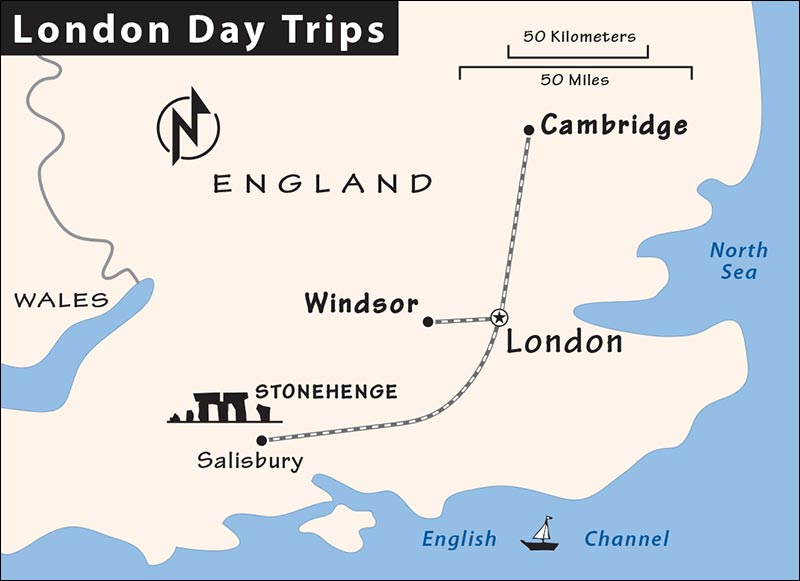
Britain’s venerable University of Cambridge is mixed into the delightful town of Cambridge, offering a mellow, fun-to-explore townscape with a big-league university.
Stonehenge, the world’s most famous rock group, sits lonesome yet adored in a mysterious field 90 miles southwest of London.
Although I only cover these three destinations in this book, London’s convenient public transit can easily whisk you to a wealth of other day-trip destinations: Bath (Roman ruins and Georgian townhouses), Canterbury (cathedral), Dover (castle-crowned chalk cliffs), Portsmouth (treasure trove of maritime history), Stratford-upon-Avon (all things Shakespeare), Warwick (fine medieval castle), Oxford (another classic university town), and Brighton (beach and pier). For details, see Rick Steves England.
By Train: Take advantage of British Rail’s discounts for day-trippers from London. The “off-peak day return” ticket is a round-trip fare that costs virtually the same as one-way, provided you depart London outside rush hour (usually after 9:30 on weekdays and anytime Sat-Sun). Be sure to specifically ask for the “day return” ticket (round-trip within a single day) rather than the more expensive standard “return.” You can also save a little money if you purchase tickets before 18:00 the day before your trip.
By Train Tour: London Walks offers a variety of “Daytrips from London” tours year-round by train, including a Salisbury and Stonehenge tour (see here ), as well as a Cambridge itinerary (see here for more on London Walks).
Windsor, a compact and easy walking town of about 30,000 people, originally grew up around the royal residence. In 1070, William the Conqueror continued his habit of kicking Saxons out of their various settlements, taking over what the locals called “Windlesora” (meaning “riverbank with a hoisting winch”)—which eventually became “Windsor.” William built the first fortified castle on a chalk hill above the Thames; later kings added on to his early designs, rebuilding and expanding the castle and surrounding gardens.
By setting up their primary residence here, modern monarchs increased Windsor’s popularity and prosperity—most notably, Queen Victoria, whose stern statue glares at you as you approach the castle. After her death, Victoria rejoined her beloved husband, Albert, in the Royal Mausoleum at Frogmore House, a mile south of the castle in a private section of the Home Park (house and mausoleum rarely open). The current Queen considers Windsor her primary residence, and the one where she feels most at home. She generally hangs her crown here on weekends, using it as an escape from her workaday grind at Buckingham Palace in the city. You can tell if Her Majesty is in residence by checking to see which flag is flying above the round tower: If it’s the royal standard (a red, yellow, and blue flag) instead of the Union Jack, the Queen is at home.
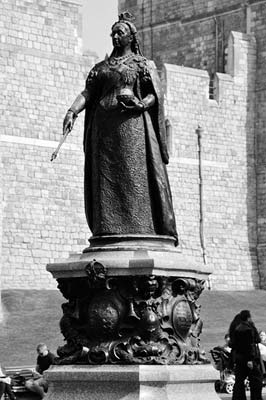
While 99 percent of visitors just come to tour the castle and go, some enjoy spending the night. Daytime crowds trample Windsor’s charm, which is most evident when the tourists are gone. Consider overnighting here—parking and access to Heathrow Airport are easy, and an evening at the horse races (on Mondays) is hoof-pounding, heart-thumping fun.
By Train: Windsor has two train stations—Windsor & Eton Central and Windsor & Eton Riverside. London’s Paddington Station connects with Windsor & Eton Central (2-3/hour, 35 minutes, easy change at Slough; £10 one-way standard class, £10-13 same-day return, www.firstgreatwestern.co.uk ). London’s Waterloo Station connects with Windsor & Eton Riverside (2/hour, no changes but slower—55 minutes; £10-13 one-way standard class, £12-20 same-day return, info tel. 0345-748-4950, www.nationalrail.co.uk ).
If you’re day-tripping into London from Windsor, ask at the train station about combining a same-day return train ticket with a Travelcard transit pass (£15-22, lower price for travel after 9:30, includes some London sightseeing discounts—ask or look for brochure at station, www.daysoutguide.co.uk ).
By Bus: Green Line buses #701 and #702 run from London’s Victoria Colonnades (between the Victoria train and coach stations) to the Parish Church stop on Windsor’s High Street, before continuing on to Legoland (1-2/hour, 1.5 hours to Windsor, £6-10 one-way, £9-16 round-trip, prices vary depending on time of day, tel. 0871-200-2233, www.firstgroup.com ).
By Car: Windsor is about 20 miles from London and just off Heathrow Airport’s landing path. The town (and then the castle and Legoland) is well-signposted from the M-4 motorway. It’s a convenient first stop if you’re arriving at Heathrow and renting a car there and saving London until the end of your trip.
From Heathrow Airport: First Bus Company’s buses #71 and #77 run between Terminal 5 and Windsor, dropping you in the center of town at the Parish Church stop on High Street (£8-11, 1-3/hour, 50 minutes, tel. 01753/524-144, www.firstgroup.com ). London black cabs can (and do) charge whatever they like from Heathrow to Windsor; avoid them by calling a local cab company, such as Windsor Cars (includes 40 minutes waiting time—handy if you checked your luggage, tel. 01753/677-677, www.windsorcars.com ).
(See "Windsor" map, here .)
Windsor’s pleasant pedestrian shopping zone litters the approach to its famous palace with fun temptations. You’ll find most shops and restaurants around the castle on High and Thames Streets, and down the pedestrian Peascod Street (PESS-cot), which runs perpendicular to High Street.
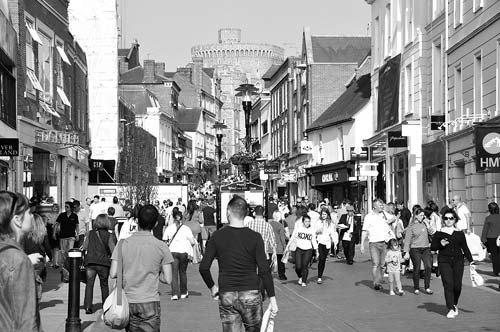
The TI is immediately adjacent to Windsor & Eton Central Station, in the Windsor Royal Shopping Centre’s Old Booking Hall (April-Oct Mon-Sat 9:30-17:00, Sun 10:00-16:00; Nov-March Sun-Fri 10:00-16:00, Sat 10:00-17:00; tel. 01753/743-900, www.windsor.gov.uk ). The TI sells discount tickets to Legoland and is extremely enthusiastic about their Royal Windsor Historical Tour.
By Train: Whichever train station you arrive at, you’re only a five-minute walk to the castle. From Windsor & Eton Central, walk through the Windsor Royal Shopping Centre (which houses the TI), and up the hill to the castle. From Windsor & Eton Riverside, you’ll see the castle as you exit—just follow the wall to the ticket office.
By Car: To get into town, follow signs from the M-4 motorway for pay-and-display parking in the center. River Street Car Park is closest to the castle, but it’s pricey and often full. The cheaper, bigger Alexandra Car Park (near the riverside Alexandra Gardens) is farther west. To walk to the town center from the Alexandra Car Park, head east through the tour-bus parking lot toward the castle. At the souvenir shop, walk up the stairs (or take the elevator) and cross the overpass to Windsor & Eton Central Station. Just beyond the station, you’ll find the TI in the Windsor Royal Shopping Centre.
The cheapest parking option is the King Edward VII Avenue car-park-and-ride, east of the castle on B-470 (£5 for 5 or more hours; includes shuttle bus into town).
Exchange Rate: £1=about $1.50.
Country Calling Code: 44 (see here for dialing instructions).
Wi-Fi: You’ll find free Wi-Fi at the library, located on Bachelors’ Acre, between Peascod and Victoria Streets (daily, tel. 01753/743-940).
Supermarkets: Pick up picnic supplies at Marks & Spencer (Mon-Sat 8:00-19:00, Sun 11:00-17:00, 130 Peascod Street, tel. 01753/852-266) or at Waitrose (Mon-Fri 8:00-21:00, Sat 8:00-20:00, Sun 11:00-17:00, King Edward Court Shopping Centre, just south of Windsor & Eton Central Station, tel. 01753/860-565). Just outside the castle, you’ll find long benches near the statue of Queen Victoria—great for people-watching while you munch.
Bike Rental: Extreme Motion, near the river in Alexandra Gardens, rents 21-speed mountain bikes (£12.50/4 hours, £18/day, includes helmet, £150 credit-card deposit required, bring passport as ID, summer daily 10:00-18:00, Sat-Sun only off-season, tel. 01753/830-220).
Windsor Castle, the official home of England’s royal family for 900 years, claims to be the largest and oldest occupied castle in the world. Thankfully, touring it is simple. You’ll see sprawling grounds, lavish staterooms, a crowd-pleasing dollhouse, a gallery of Michelangelo and Leonardo da Vinci drawings, and an exquisite Perpendicular Gothic chapel.
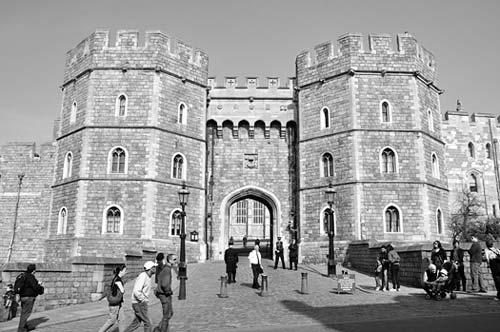
Cost: £20, includes entry to castle grounds and all exhibits inside. Tickets are valid for one year of reentry (get it stamped at the exit).
Crowd Control: Ticket lines can be long in summer. You can expect the worst crowds between 11:00-13:00 any time of year. Avoid the wait by purchasing tickets in advance online at www.royalcollection.org.uk (collect them at the prepaid ticket window), or in person at the Buckingham Palace ticket office in London. There’s nowhere in Windsor to buy advance tickets.
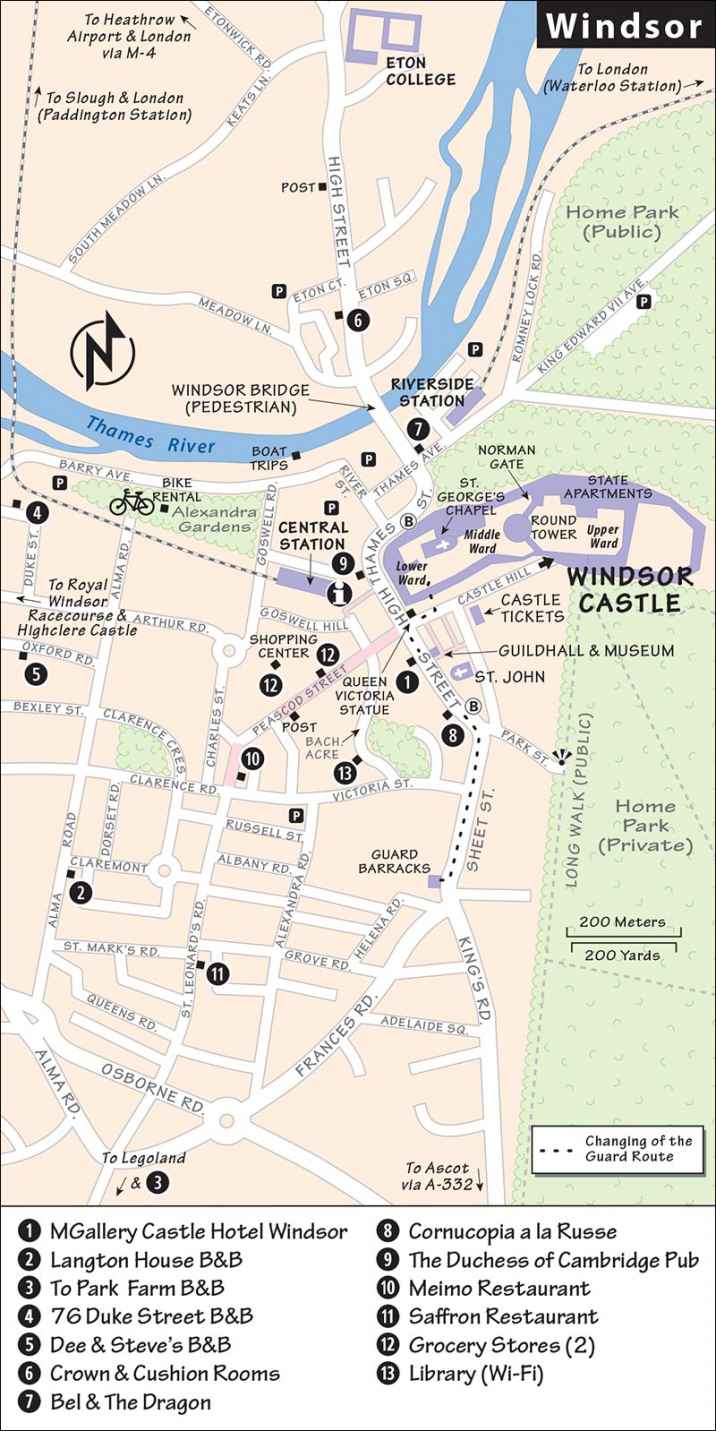
Hours: Grounds and most interiors open daily March-Oct 9:30-17:15, Nov-Feb 9:45-16:15, except St. George’s Chapel, which is closed Sun to tourists (but open to worshippers; wait at the exit gate to be escorted in). Last entry to grounds and St. George’s Chapel 75 minutes before closing. Last entry to State Apartments and Queen Mary’s Dolls’ House 45 minutes before closing.
Possible Closures: On rare occasions when the Queen is entertaining guests, the State Apartments close (and tickets are reduced to £10.80). Sometimes the entire castle closes. It’s smart to call ahead or check the website (especially in mid-June) to make sure everything is open when you want to go. While you’re at it, confirm the Changing of the Guard schedule.
Information: Tel. 020/7766-7324, www.royalcollection.org.uk .
Tours: An included audioguide (dry, reverent, informative) covers both the grounds and interiors. For a good overview—and an opportunity to ask questions—consider the free 30-minute guided walk around the grounds (usually 2/hour, schedule posted next to audioguide desk). The official £5 guidebook is full of gorgeous images and makes a fine souvenir, but the information within is covered by the audioguide and tour.
Photography: Taking photographs inside any of the buildings is strictly forbidden.
Changing of the Guard: The Changing of the Guard takes place Monday through Saturday at 11:00 (April-July) and on alternating days the rest of the year (check website to confirm schedule; get there by 10:30 or earlier if you expect a line for tickets). There is no Changing of the Guard on Sundays or in very wet weather. The fresh guards, led by a marching band, leave their barracks on Sheet Street and march up High Street, hanging a right at Victoria, then a left into the castle’s Lower Ward, arriving at about 11:00. After about a half-hour, the tired guards march back the way the new ones came. To watch the actual ceremony inside the castle, you’ll need to have already bought your ticket, entered the grounds, and staked out a spot. Alternatively, you could wait for them to march by on High Street or on the lower half of Castle Hill.
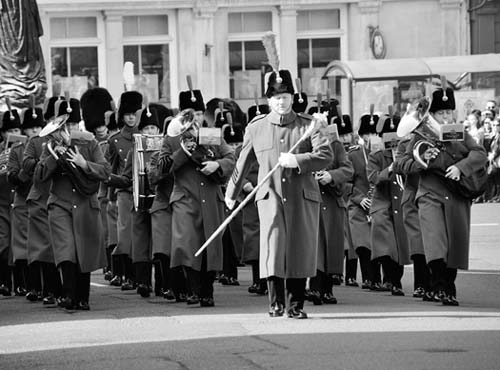
Evensong: An evensong takes place in the chapel nightly at 17:15 (free for worshippers, line up at exit gate to be admitted).
Best View: While you can get great views of the castle from any direction, the classic views are from the long, wooded walkway called the Long Walk, which stretches south of the palace and is open to the public.
Eating: There are no real eateries inside (other than shops selling gifty boxes of chocolates and bottled water), so consider bringing a snack with you.
 Self-Guided Tour
Self-Guided Tour
After buying your ticket and going through the security checkpoint, pick up your audioguide and start strolling along the path through...
The Grounds: Head up the hill, enjoying the first of many fine castle views you’ll see today. The tower-topped conical hill on your left represents the historical core of the castle. William the Conqueror built this motte (artificial mound) and bailey (fortified stockade around it) in 1080—his first castle in England. Among the later monarchs who spiffed up Windsor were Edward III (flush with French war booty, he made it a palace fit for a 14th-century king), Charles II (determined to restore the monarchy properly in the 1660s), and George IV (Britain’s “Bling King,” who financed many such vanity projects in the 1820s). On your right, the circular bandstand platform has a seal of the Order of the Garter, which has important ties to Windsor (see sidebar).
Passing through the small gate, you approach the stately St. George’s Gate. Peek through here to the Upper Ward’s Quadrangle, which is surrounded by the State Apartments (across the field) and the Queen’s private apartments (to the right).
Turn left and follow the wall. On your right-hand side, you enjoy great views of the Round Tower atop that original motte; running around the base of this artificial hill is the delightful, peaceful garden of the castle governor. The unusual design of this castle has not one “bailey” (castle yard), but three, which today make up Windsor’s Upper Ward (where the Queen lives, which we just saw), Middle Ward (the ecclesiastical heart of the complex, with St. George’s Chapel, which you’ll soon pass on the left), and Lower Ward (residences for castle workers).
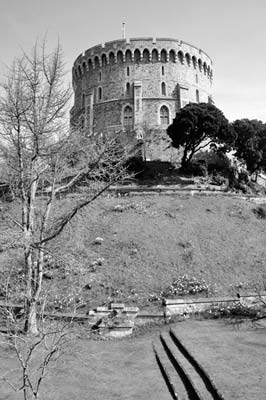
Continue all the way around this minimoat to the Norman Gate, which once held a prison. Walking under the gate, look up to see the bottom of the portcullis that could be dropped to seal off the inner courtyard. Three big holes are strategically situated for dumping boiling goo or worse on whoever was outside the gate. Past the gate are even finer views of the Quadrangle we just saw from the other side.
Do a 180 and head back toward the Norman Gate, but before you reach it, go down the staircase on the right. You’ll emerge onto a fine terrace overlooking the flat lands all around. It’s easy to understand why this was a strategic place to build a castle. That’s Eton College across the Thames. Imagine how handy it’s been for royals to be able to ship off their teenagers to an elite prep school so close that they could easily keep an eye on them...literally. The power-plant cooling towers in the distance mark the workaday burg of Slough (rhymes with “plow,” immortalized as the setting for Britain’s original version of The Office ).
• Turn right and wander along the terrace. You’ll likely see two lines. The long one leads to Queen Mary’s Dolls’ House, then to the State Apartments. The short line skips the dollhouse and heads directly to the apartments. Read the following descriptions and decide if the dollhouse is worth waiting for (or try again later in the day, when the line sometimes eases up). You can see the Drawings Gallery and the China Museum either way.
Queen Mary’s Dolls’ House: This palace in miniature (1:12 scale, from 1924) is “the most famous dollhouse in the world.” It was a gift for Queen Mary (the wife of King George V, and the current Queen’s grandmother), who greatly enjoyed miniatures, when she was already a fully-grown adult. It’s basically one big, dimly lit room with the large dollhouse in the middle, executed with an astonishing level of detail. Each fork, knife, and spoon on the expertly set banquet table is perfect and made of real silver—and the tiny pipes of its plumbing system actually have running water. But you’re kept a few feet away by a glass wall, and are constantly jostled by fellow sightseers in this crowded space, making it difficult to fully appreciate. Unless you’re a dollhouse devotee, it’s probably not worth waiting half an hour for a five-minute peek at this, but if the line is short it’s definitely worth a look.
Drawings Gallery and China Museum: Positioned at the exit of Queen Mary’s Dolls’ House, this gallery displays a changing array of pieces from the Queen’s collection—usually including some big names, such as Michelangelo and Leonardo. The China Museum features items from the Queen’s many exquisite settings for royal shindigs.
State Apartments: Dripping with chandeliers, finely furnished, and strewn with history and the art of a long line of kings and queens, they’re the best I’ve seen in Britain. This is where Henry VIII and Charles I once lived, and where the current Queen wows visiting dignitaries. Take advantage of the talkative docents in each room, who are happy to answer your questions.
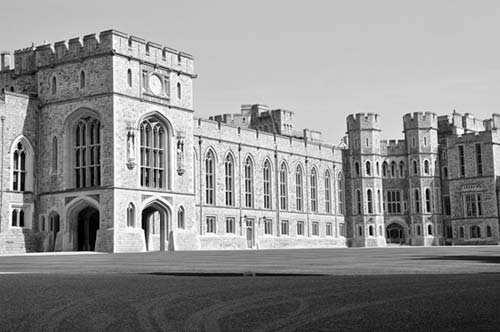
You’ll climb the Grand Staircase up to the Grand Vestibule, decorated with exotic items seized by British troops during their missions to colonize various corners of the world. Ask a docent to help you find the bullet that killed Lord Nelson at Trafalgar (in one of the many glass cases). In the next room, the magnificent wood-ceilinged Waterloo Chamber is wallpapered with portraits of figures from the pan-European alliance that defeated Napoleon. Find General Wellington (high on the far wall, in red) who outmaneuvered him at Waterloo, and Pope Pius VII (right wall, in red and white) whom Napoleon befriended...then imprisoned. Next, you’ll pass through a series of living rooms —bedchambers, dressing rooms, and drawing rooms of the king and queen (who traditionally maintained separate quarters). Many rooms are decorated with canvases by Rubens, Van Dyck, and Holbein. Finally you emerge into St. George’s Hall, decorated with emblems representing the knights of the prestigious Order of the Garter (see sidebar). This is the site of some of the most elaborate royal banquets—imagine one long table stretching from one end of the hall to the other, seating 160 VIPs. From here, you’ll proceed into the rooms that were restored after a fire in 1992, including the “Semi-State Apartments.” The Garter Throne Room is where new members of the Order of the Garter are invested (ceremonially granted their titles).
• Exiting the State Apartments, you have one more major sight to see. Get out your castle-issued map or follow signs to find...
St. George’s Chapel: This church is known for housing numerous royal tombs, and is an exquisite example of the Perpendicular Gothic style (dating from about 1500). Pick up a free map and circle the interior clockwise, finding these highlights:
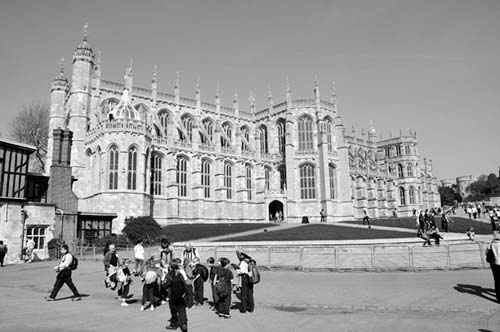
Stand at the back and look down the nave, with its classic fan-vaulting spreading out from each slender pillar and nearly every joint capped with an elaborate and colorful roof boss. Most of these emblems are associated with the Knights of the Garter, who consider St. George’s their “mother church.” Under the upper stained-glass windows, notice the continuous frieze of 250 angels, lovingly carved with great detail, ringing the church.
In the corner (#4 on your church-issued map), take in the melodramatic monument to Princess Charlotte of Wales, the only child of King George IV. Heir to the throne, her death in 1817 (at 21, in childbirth) devastated the nation. Head up the left side of the nave and find the simple chapel (#6) containing the tombs of the current Queen’s parents, King George VI and “Queen Mum” Elizabeth; the ashes of her younger sister, Princess Margaret, are also kept here (see the marble slab against the wall). It’s speculated that the current Queen may choose this chapel for her final resting place. Farther up the aisle is the tomb of Edward IV (#8), who expanded St. George’s Chapel.
Stepping into the choir area (#12), you’re immediately aware that you are in the inner sanctum of the Order of the Garter. The banners lining the nave represent the knights, as do the fancy helmets and half-drawn swords at the top of each wood-carved seat. These symbols honor only living knights; on the seats are some 800 golden panels memorializing departed knights. Under your feet lies the Royal Vault (#13), burial spot of Mad King George III (nemesis of American revolutionaries). Strolling farther up the aisle, notice the marker in the floor: You’re walking over the burial site of King Henry VIII (#14) and Jane Seymour, Henry’s favorite wife (perhaps because she was the only one who died before he could behead her). The body of King Charles I, who was beheaded by Oliver Cromwell’s forces at the Banqueting House (see here ), was also discovered here...with its head sewn back on.
On your way out, you can pause at the door of the sumptuous 13th-century Albert Memorial Chapel (#28), redecorated in 1861 after the death of Queen Victoria’s husband, Prince Albert, and dedicated to his memory.
• On exiting the chapel, you come into the castle’s...
Lower Ward: This area is a living town where some 160 people who work for the Queen reside; they include clergy, military, and castle administrators. Just below the chapel, you may be able to enter a tranquil little horseshoe-shaped courtyard ringed with residential doorways—all of them with a spectacular view of the chapel’s grand entrance.
Back out in the yard, look for the guard posted at his pillbox. Like those at Buckingham Palace, he’s been trained to be a ruthless killing machine...just so he can wind up as somebody’s photo op. Click!
Paradise for Legomaniacs under age 12, this huge, kid-pleasing park has dozens of tame but fun rides (often with very long lines) scattered throughout its 150 acres. The impressive Miniland has 40 million Lego pieces glued together to create 800 tiny buildings and a minitour of Europe; the Creation Centre boasts an 80 percent scale-model Boeing 747 cockpit, made of two million bricks. Several of the more exciting rides involve getting wet, so dress accordingly or buy a cheap disposable poncho in the gift shop. While you may be tempted to hop on the Hill Train at the entrance, it’s faster and more convenient to walk down into the park. Food is available in the park, but you can save money by bringing a picnic.
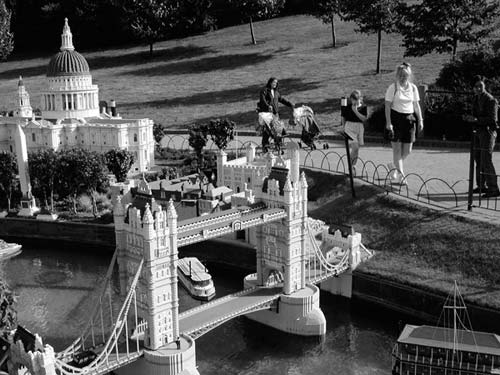
Cost: Adults-£51, children-£46, 25 percent cheaper booked online at least seven days in advance, 10 percent discount at Windsor TI, free for ages 3 and under; optional Q-Bot ride-reservation gadget allows you to bypass lines (£20-75 depending on when you go and how much time you want to save).
Hours: Convoluted schedule, but generally late July-Aug daily 10:00-19:00; mid-March-late July and Sept-Oct Mon-Fri 10:00-17:00, Sat-Sun 10:00-18:00, often closed Tue-Wed; closed Nov-mid-March. Call or check website for exact schedule, tel. 0871-222-2001, www.legoland.co.uk .
Getting There: A £5 round-trip shuttle bus runs from opposite Windsor’s Theatre Royal on Thames Street, and from the Parish Church stop on High Street (2/hour). If day-tripping from London, ask about rail/shuttle/park admission deals from Paddington or Waterloo train stations. For drivers, the park is on B-3022 Windsor/Ascot road, two miles southwest of Windsor and 25 miles west of London. Legoland is clearly signposted from the M-3, M-4, and M-25 motorways. Parking is easy (£5).
Across the bridge from Windsor Castle is the most famous “public” (the equivalent of our “private”) high school in Britain. Eton was founded in 1440 by King Henry VI; today it educates about 1,300 boys (ages 13-18), who live on campus. Eton has molded the characters of 19 prime ministers as well as members of the royal family, most recently princes William and Harry. Sparse on actual sights, the college is closed to visitors except via guided tour, where you may get a glimpse of the schoolyard, chapel, cloisters, and the Museum of Eton Life. For more information visit www.etoncollege.com or call 01753/370-000.
Even if you’re not touring the college, it’s worth the few minutes it takes to cross the pedestrian bridge and wander straight up Eton’s High Street. A bit more cutesy and authentic-feeling than Windsor (which is given over to shopping malls and chain stores), Eton has a charm that’s fun to sample.
Tucked into a small space beneath the Guildhall (where Prince Charles remarried), this little museum does its best to give some insight into the history of Windsor and the surrounding area. They also have lots of special activities for kids. Ask at the desk whether tours are running to the Guildhall itself (visits only possible with a guide); if not, it’s probably not worth the admission.
Cost and Hours: £2, includes audioguide, Tue-Sat 10:00-16:00, Sun 12:00-16:00, closed Mon, located in the Guildhall on High Street, tel. 01628/685-686, www.rbwm.gov.uk .
Cruise up and down the Thames River for classic views of the castle, the village of Eton, Eton College, and the Royal Windsor Racecourse. Choose from a 40-minute or two-hour tour, then relax onboard and nibble a picnic. Boats leave from the riverside promenade adjacent to Barry Avenue.
Cost and Hours: 40-minute tour-£7.40, family pass-about £20, mid-Feb-Oct 1-2/hour daily 10:00-17:00, fewer and Sat-Sun only in Nov; 2-hour tour—£11.50, family pass-about £35, late March-Oct only, 1-2/day; closed Dec-mid-Feb; online discounts, tel. 01753/851-900, www.frenchbrothers.co.uk .
The horses race near Windsor every Monday at the Royal Windsor Racecourse (£21-25 entry, online discounts, under age 18 free with an adult, April-Aug and Oct, no races in Sept, sporadic in Aug, off A-308 between Windsor and Maidenhead, tel. 01753/498-400, www.windsor-racecourse.co.uk ). The romantic way to get there from Windsor is by a 10-minute shuttle boat (£6.50 round-trip, www.frenchbrothers.co.uk ). The famous Ascot Racecourse (described next) is also nearby.
Located seven miles southwest of Windsor and just north of the town of Ascot, this royally owned track is one of the most famous horse-racing venues in the world. The horses first ran here in 1711, and the course is best known for June’s five-day Royal Ascot race meeting, attended by the Queen and 299,999 of her loyal subjects. For many, the outlandish hats worn on Ladies Day (Thu) are more interesting than the horses. Royal Ascot is usually the third week in June (June 20-24 in 2017). The pricey tickets go on sale the preceding November; while the Friday and Saturday races tend to sell out far ahead, tickets for the other days are often available close to the date (check website). In addition to Royal Ascot, the racecourse runs the ponies year-round—funny hats strictly optional.
Cost: Regular tickets generally start from £13 and go as high as £80—may be available at a discount at TI, Royal Ascot £21-80, kids ages 17 and under free; parking-free-£20, depending on event; dress code enforced in some areas and on certain days, tel. 0844-346-3000, www.ascot.co.uk .
Most visitors stay in London and do Windsor as a day trip. But here are a few suggestions for those staying the night.
$$$$ MGallery Castle Hotel Windsor, part of the boutique division of Accor Hotels, offers 108 rooms and elegant public spaces in a location that’s as central as can be, just down the street from Her Majesty’s weekend retreat (breakfast extra, air-con, parking-£15/day, 18 High Street, tel. 01753/851-577, www.castlehotelwindsor.com , h6618@accor.com ).
$$ Langton House B&B is a stately Victorian home with five spacious, well-appointed rooms lovingly maintained by Paul and Sonja Fogg (continental breakfast included but full English breakfast extra, family rooms, guest kitchen, 46 Alma Road, tel. 01753/858-299, www.langtonhouse.co.uk , bookings@langtonhouse.co.uk ).
$$ Park Farm B&B, bright and cheery, is most convenient for drivers. But even if you’re not driving, this beautiful place is such a good value, and the welcome is so warm, that you’re unlikely to mind the bus ride into town (cash only—credit card solely for reservations, family room with bunk beds, shared fridge and microwave, free off-street parking, 1 mile from Legoland on St. Leonards Road near Imperial Road, 5-minute bus ride or 1-mile walk to castle, £5 taxi ride from station, tel. 01753/866-823, www.parkfarm.com , stay@parkfarm.com , Caroline and Drew Youds).
$$ 76 Duke Street has two nice rooms, but only hosts one set of guests at a time. While the bathroom is (just) outside your bedroom, you have it to yourself (15-minute walk from station at—you guessed it—76 Duke Street, tel. 01753/620-636 or 07884/222-225, www.76dukestreet.co.uk , bandb@76dukestreet.co.uk , Julia).
$ Dee and Steve’s B&B is a friendly four-room place above a window shop on a quiet residential street about a 10-minute walk from the castle and station. The rooms are cozy, Dee and Steve are pleasant hosts, and breakfast is served in the contemporary kitchen/lounge (169 Oxford Road, tel. 01753/854-489, www.deeandsteve.com , dee@deeandsteve.com ).
$ Crown and Cushion is a good option on Eton’s High Street, just across the pedestrian bridge from Windsor’s waterfront (a short uphill walk to the castle). While the pub it’s situated over is worn and drab, you’re right in the heart of charming Eton, and the eight creaky rooms—with uneven floors and old-beam ceilings—are nicely furnished (free parking, 84 High Street in Eton, tel. 01753/861-531, www.thecrownandcushioneton.co.uk , info@thecrownandcushioneton.com ).
(See "Windsor" map, here .)
Elegant Spots with River Views: Several places flank Windsor Bridge, offering romantic dining after dark. The riverside promenade, with cheap takeaway stands scattered about, is a delightful place for a picnic lunch or dinner with the swans. If you don’t see anything that appeals, continue up Eton’s High Street, which is also lined with characteristic eateries.
In the Tourist Zone Around the Palace: Strolling the streets and lanes around the palace entrance—especially in the shopping zone near Windsor & Eton Station—you’ll find countless trendy and inviting eateries. The central area also has a sampling of dependable British chains (including a Wagamama, Gourmet Burger Kitchen, and Thai Square). Residents enjoy a wide selection of unpretentious little eateries (including a fire station turned pub-and-cultural center) just past the end of pedestrian Peascod Street.
$$$ Bel & The Dragon is the place to splurge on high-quality classic British food in a charming half-timbered building with an upscale-rustic dining space (food served daily 12:00-15:00 & 18:00-22:00, afternoon tea served between lunch and dinner, bar open longer hours, on Thames Street near the bridge to Eton, tel. 01753/866-056).
$$$ Cornucopia a la Russe, with a cozy, woody atmosphere, serves tasty international dishes (two- and three-course lunch deals, open Mon-Sat 12:00-14:30 & 18:00-21:30, Fri-Sat until 22:00, closed Sun, 6 High Street, tel. 01753/833-009).
$$ The Duchess of Cambridge ’s friendly staff serves up the normal grub in a pub that’s right across from the castle walls, and with an open fireplace to boot (daily 10:00-23:00 or later, 3 Thames Street, tel. 01753/864-405). While the pub predates Kate, it was named in her honor following a recent remodel, and has the photos to prove her endorsement.
$$ Meimo offers “Mediterranean/Moroccan” cuisine in a nicely subdued dining room at the quieter end of the pedestrian zone (several fixed-price meal options, daily 10:00-22:00, 69 Peascod Street, tel. 01753/862-222).
$$ Saffron restaurant, while a fairly long walk from the castle, is the local choice for South Indian cuisine, with a modern interior and attentive waiters who struggle with English but are fluent at bringing out tasty dishes. Their vegetarian thali is a treat (daily 12:00-14:30 & 17:30-23:30, 99 St. Leonards Road, tel. 01753/855-467).
Cambridge, 60 miles north of London, is world-famous for its prestigious university. Wordsworth, Isaac Newton, Tennyson, Darwin, and Prince Charles are a few of its illustrious alumni. The university dominates—and owns—most of Cambridge, a historic town of about 125,000 people. Cambridge is the epitome of a university town, with busy bikers, stately residence halls, plenty of bookshops, and proud locals who can point out where DNA was originally modeled, the atom first split, and electrons discovered.
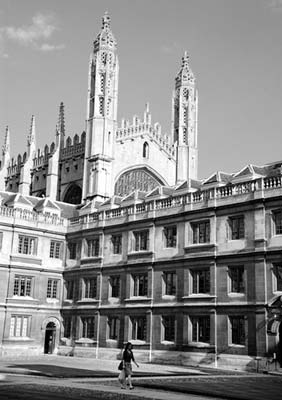
In medieval Europe, higher education was the domain of the Church and was limited to ecclesiastical schools. Scholars lived in “halls” on campus. This academic community of residential halls, chapels, and lecture halls connected by peaceful garden courtyards survives today in the colleges that make up the universities of Cambridge and Oxford. By 1350 (Oxford is roughly 100 years older), Cambridge had eight colleges, each with a monastic-type courtyard, chapel, library, and lodgings. Today, Cambridge has 31 colleges, each with its own facilities, and about 12,000 undergrads. In the town center, these grand old halls date back centuries, with ornately decorated facades that try to one-up each other. While students’ lives revolve around their independent colleges, the university organizes lectures, presents degrees, and promotes research.
The university schedule has three terms: Lent term from mid-January to mid-March, Easter term from mid-April to mid-June, and Michaelmas term from early October to early December. During exams (roughly the month of May), the colleges are closed to visitors, which can impede access to some of the town’s picturesque little corners. But the main sights—King’s College Chapel and the Wren Library at Trinity College—stay open, and Cambridge is never sleepy.
Cambridge can easily be seen as a day trip from London. A good five-hour plan is to follow my self-guided walk, spend an hour on a punt ride, tour the Fitzwilliam Museum (closed Mon), and see the Wren Library at Trinity College (open Mon-Sat for only two hours a day, so plan ahead). For a little extra color, consider joining a walk through town with a local guide from the TI (2 hours, repeats much of my self-guided walk but splices in local flavor). The TI’s town walk includes King’s College Chapel, so don’t do that on your own.
If you’re in town for the evening, the evensong service at King’s College Chapel (Mon-Sat at 17:30, Sun at 15:30) is a must. If you like plays and music, events are always happening in this thriving cultural hub.
By Train: It’s an easy trip from London and less than an hour away. Catch the train from London’s King’s Cross Station (2/hour, trains leave King’s Cross at :15 and :44 past the hour, 45 minutes, £23.20 one-way standard class, £24.20 same-day return after 9:30, tel. 0845-748-4950, www.thameslinkrailway.com or www.nationalrail.co.uk ). Cheaper direct trains also run from London’s Liverpool Street Station, but take longer (2/hour, 1.5 hours).
By Bus: National Express X90 coaches run from London’s Victoria Coach Station to the Parkside stop in Cambridge (every 60-90 minutes, 2 hours, £12-22, discounted fares may be available in advance online, tel. 0871-781-8181, www.nationalexpress.co.uk ).
(See "Cambridge" map, here .)
Cambridge is small. Everything is within a pleasant walk. The town has two main streets, separated from the Cam River by the most interesting colleges. The town center, brimming with tearooms, has a TI and a colorful open-air market square. The train station is about a mile to the southeast.
Cambridge’s TI is well run and well signposted, just off Market Square in the town center. They book rooms for £5, offer walking tours (see “Tours in Cambridge,” later), and sell bus tickets and a £2 map/guide (Mon-Sat 10:00-17:00, Easter-Sept also Sun 11:00-15:00—otherwise closed Sun, phones answered from 9:00, Peas Hill, tel. 01223/791-500, www.visitcambridge.org ). In the same building as the TI, you can duck into a former courtroom to catch a free video overview of the town and its history.
By Train: Cambridge’s train station doesn’t have baggage storage or a TI. You can pick up a free map at the small info desk on the platform and other brochures on an interior wall to the left of the turnstiles.
To get from the station to downtown Cambridge, you can walk for about 25 minutes (exit straight ahead on Station Road, bear right at the war memorial onto Hills Road, and follow it into town); take public bus #1, #3, or #7 (referred to as “Citi 1,” “Citi 3,” and so on in schedules, but buses are marked only with the number; £1.60, pay driver, runs every 5-10 minutes, turn left when exiting station, cross the street, and walk half a block to find bus stands, get off when you see Lion’s Yard shopping mall on the left); pay about £6 for a taxi; or take a City Sightseeing bus tour (described later).
By Car: To park in the middle of town, follow signs from the M-11 motorway to any of the central (but expensive) short-stay parking lots—including one at the central shopping mall, Lion’s Yard. Or leave your car at one of six park-and-ride lots outside the city, then take the shuttle into town (parking-£1/4 hours; shuttle-£2.70 round-trip).
Exchange Rate: £1=about $1.50.
Country Calling Code: 44 (see here for dialing instructions).
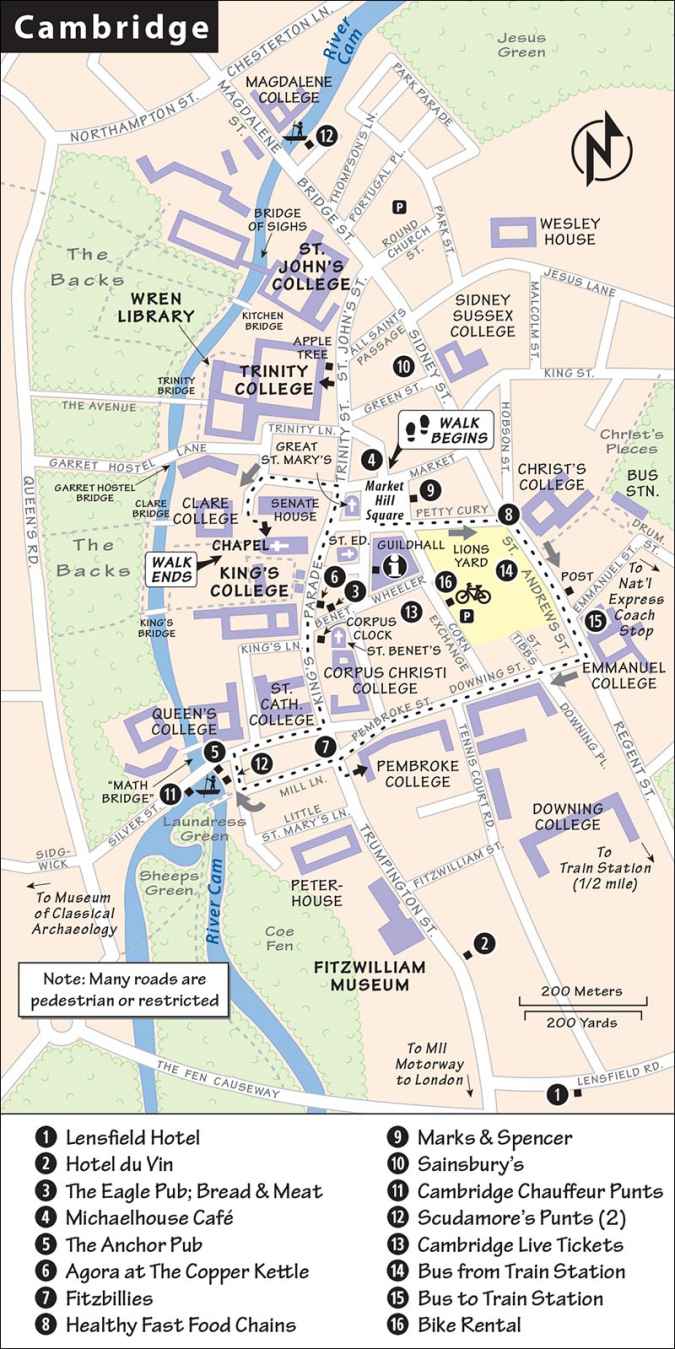
Live Theater and Entertainment: With all the smart and talented students in town, there is always something going on. Make a point of enjoying a play or concert. The ADC (Cambridge University Amateur Dramatic Club) is Britain’s oldest university playhouse, offering a steady stream of performances since 1855. It’s lots of fun and casual, with easy-to-get and inexpensive tickets. This is your chance to see a future Emma Thompson or Ian McKellen—alums who performed here as students—before they become stars (tel. 01223/300-085, www.adctheatre.com ).
Cambridge Live Tickets is a very helpful service, offering event info and ticket sales in person and online (Mon-Fri 12:00-18:00, Sat from 10:00, Sun from 18:00 until 30 minutes before showtime, 2 Wheeler Street, tel. 01223/357-851 answered Mon-Sat 10:00-18:00, www.cambridgelivetrust.co.uk ). The TI also has lists of what’s on.
Festivals: The Cambridge Folk Festival gets things humming and strumming in late July (tickets go on sale several months ahead and often sell out; www.cambridgefolkfestival.co.uk ). From mid-July through August, the town’s Shakespeare Festival attracts 25,000 visitors for outdoor performances in some of the college’s gardens (£16, book tickets online, www.cambridgeshakespeare.com ).
Bike Rental: Rutland Cycling, inside the Lion’s Yard shopping mall, offers pay luggage lockers and rents bikes (£7/4 hours, £10/day, helmets-£1, £60 deposit); Mon-Fri 8:00-18:00, Sat 9:00-18:00, Sun 10:00-17:00; tel. 01223/307-655, www.rutlandcycling.com .
A walking tour is the best way to understand Cambridge’s mix of “town and gown.” The walks can be more educational (read: dry) than entertaining, but they do provide a good rundown of the historic and scenic highlights of the university, some fun local gossip, and plenty of university trivia.
The TI offers daily walking tours that include the King’s College Chapel, as well as another college—usually Queen’s College (£18, 2 hours, includes entry fees; July-Aug daily at 11:00, 12:00, 13:00, and 14:00, no 11:00 tour on Sun; generally fewer tours rest of the year—check website for schedule; tel. 01223/791-500, www.visitcambridge.org ). Groups are limited to 20, so it’s smart to call ahead or drop in at the TI in advance to reserve a spot. Note that the 12:00 tour overlaps with the limited opening times of the Wren Library, so you’ll miss out on the library if you take the noon tour.
Private guides are available through the TI and affordable if you can assemble a group to share the cost (2-hour tour-£88; does not include individual college entrance fees, tel. 01223/791-500, tours@visitcambridge.org ).
If you’re in Cambridge on the weekend, consider a £6 “ghost walk” to where spooky sightings have been reported (Fri-Sat at 18:00, organized by the TI, tel. 01223/791-500).
City Sightseeing hop-on, hop-off bus tours are informative and cover the outskirts, including the American WWII Cemetery. But keep in mind that buses can’t go where walking tours can—right into the center (£15, 80 minutes for full 19-stop circuit, buy ticket with credit card at the bus-stop kiosk—or pay cash to driver when you board, departs every 20 minutes in summer, every 40 minutes in winter, first bus leaves train station around 10:00, last bus around 17:30, recorded commentary, tel. 01223/433-250, www.city-sightseeing.com ). If arriving by train, you can buy your ticket from the kiosk directly in front of the station, then ride the bus into town.
(See "Cambridge" map, here .)
Cambridge is built along its dreamy little river and around its 31 colleges (the first, Peterhouse, was founded in the 1280s). It’s easy to sort out. There’s a small and youthful commercial center—quiet and traffic free (except for lots of bikes), one important museum (the Fitzwilliam), and lots of minor museums (all generally free). The Cam River has boat tours, three public bridges, and a strip of six colleges whose gardens basically own the river through the center of town and make it feel like an exclusive park. The university includes two dominant colleges (Trinity with its famous Wren Library, and King’s College with its famous chapel), but also plenty of minor ones, each with a grand front gate. The city is filled with students year-round—scholars throughout the regular terms and visiting students enjoying summer programs.
In the following self-guided walk, I cover the essential town sights (including two less-visited colleges), finishing at King’s College Chapel. Trinity College and the Fitzwilliam Museum are covered in “Sights in Cambridge,” later.
• Start this self-guided walk on Market Hill Square (the TI is just half a block away). To find the square from the lively street called King’s Parade—which feels like the center of town and is where this walk ends—go behind Great St. Mary’s Church (with the tall tower).
This square has been a center of commerce for more than a thousand years. Think of the history this place has seen: Romans first built a bridge over the Cam in A.D. 43, Anglo-Saxons and Danes established a market here in the Dark Ages, and Normans built a castle here (now gone) in the 11th century.
But the big year was 1209, when scholars and students first arrived. After scuffles in Oxford between its townsfolk and university (which is older than Cambridge), Oxford’s students and professors fled here and settled. (The Oxford-Cambridge rivalry just seems natural.) Where’s the university? Everywhere, mixed into the town, with the 31 individual colleges, university halls, and student dorms scattered about. Even on this square you can see dorms (the more modern, tasteless buildings around you). Cambridge suffered no bomb damage in World War II, so the older buildings you see are originals. As you walk, notice how peaceful the town is. Almost no cars, but bikes everywhere—be careful! They are silent and pack a punch.
The Guildhall facing this square (the seat of the city council today) overlooks market stalls. The big market is on Sunday (9:30-16:30) and features produce, arts, and crafts. On other days, you’ll find mostly clothes and food (Mon-Sat generally 9:30-16:00).
• Facing the Guildhall, exit the square to your left down Petty Curry Lane, a modern pedestrian shopping street. At its end (with my three favorite fast-food chains: Eat, Pret, and Wasabi) you hit St. Andrews Street. On the left is the fine 16th-century gatehouse of Christ’s College. Step inside to enjoy the classic court, next to a bust of Charles Darwin (a notable alum). The college is open to the public daily 9:00-16:00 if you want to poke around. Otherwise continue down St. Andrews Street a long block to Emmanuel College.
This college welcomes the public and offers a classic peek at a typical Cambridge college (free, open 9:00-18:00). Emmanuel was founded in 1584 as a Protestant college on land that had once been a Dominican friary. (Like many monasteries and convents in the 16th century, the friary had been dissolved by the English king in an epic power struggle that left England with its own version of Christianity and the government with lots of land once owned by the Catholic Church.)
Facing the court, with the big clock, is one of two chapels in town designed by Christopher Wren. Above the church is the Senior Common Room, a social hall for college fellows. On the left is the dining hall—marked by its big bay window.
At this point you could visit the church (find the portrait of John Harvard—the Emmanuel College student who went to America and founded another prestigious school—in the stained glass on the left), look through the doorway into the dining hall, enjoy the garden behind the chapel (typical of these colleges; the fish pond goes back to monastic days when the fish were part of the diet), or chat with the porter.
• Leaving Emmanuel College, walk straight ahead along Downing Street. You’ll pass several museums that are owned by the university to support various fields of study (generally free to enter). Downing Street ends at King’s Parade, with Pembroke College on the left and the recommended Fitzbillies Café on the right (famous for its local cinnamon roll, the Chelsea Bun).
Founded in 1347, Pembroke is the third-oldest college in Cambridge. Step into the court, past the porter’s lodge—it’s polite to say hello and ask whether you can wander around. Survey the court. Two chapels face it. The original chapel (on the left) was replaced by the bigger one on the right. Ahead of you is the medieval dining hall, and the fancy building with the pointed clock tower is the library (the statue in front is alumnus William Pitt the Younger—a great 18th-century prime minister), with a charming garden beyond.
The highlight here is the chapel on the right. The chapel dates from about 1660 and is the first building that the famed architect Christopher Wren completed. Before stepping inside to enjoy the interior, pause for a moment at the somber WWI and WWII memorial.
• From Pembroke College, cross King’s Parade and follow Mill Lane directly down to the River Cam and its mill pond.
From this perch you see the “harbor action” of Cambridge. The city was a sort of harbor in medieval times: Trading vessels from the North Sea could navigate to here. Today a weir divides the River Cam from the River Granta (on the left), which leads through idyllic countryside to the town of Grantchester. Filling the mill pond is a commotion of the iconic Cambridge boats called punts (note that punts cannot cross the weir). Students hustle to take visitors on a 45-minute trip along the parklike “backs” of the colleges that line the river from here to the far side of town (about £20, see here ). You can share a boat with others and enjoy a colorful narration as you’re poled past fine college architecture. Skilled residents rent boats for themselves, as do not-so-skilled tourists—much to the amusement of locals who sip their beer while watching clumsy visitors fumble with the boats (which are tougher to maneuver than they look).
Walk along the harbor past the recommended Anchor Pub (with waterfront tables and fancier seating upstairs) to the Silver Street Bridge. From here you can watch more punt action and check out the famous “Mathematical Bridge,” which links the old and new buildings of Queens’ College. This wooden bridge, although curved, is made of straight boards. (It was not designed by Isaac Newton, as a popular fable would have it—Newton died before the bridge was constructed.)
Gazing upstream past the wooden bridge, you see the start of the stretch of six colleges, each with a bridge that connects their campus complexes with the garden-like “backs.”
• Walk up Silver Street, back to King’s Parade, and turn left toward this walk’s finale—King’s College. On the first corner, find the fancy gilded clock.
Designed and commissioned by Corpus Christi College alum John Taylor, this clock was unveiled by Cambridge physicist Stephen Hawking in a 2008 ceremony. Perched on top is the Chronophage—the “time eater”—a grotesque giant grasshopper that keeps the clock moving and periodically winks at passersby. The message? Time is passing, so live every moment to the fullest.
The Eagle Pub, a venerable joint, is just down Benet Street on the left. This is Cambridge’s oldest pub and a sight in itself. Poke into the courtyard and atmospheric rooms even if you don’t eat or drink here.
From the courtyard outside, look up at the balcony of second-floor guest rooms that date back to when this was a coachmen’s inn as well as a pub. (It’s said that in Shakespeare’s time, plays were performed from this perch to entertain guests below.) The faded Bath sign indicates that this was a posh place—you could even wash. Notice that the window on the right end is open; any local will love to tell you why.
Step past the “glancing stones” that protected the corner from careening coaches. During World War II, US Army Air Corps pilots famously hung out here before missions over Germany. The fun interior is plastered with stickers of air crews and WWII memorabilia. Next to the fireplace a photo and plaque remember two esteemed regulars—Francis Crick and James Watson—the scientists who first described the structure of DNA. They announced their finding here in 1953, and if you’d like to drink to that, there’s a beer on tap for you—a bitter called DNA.
St. Benet’s Church, across the street from the pub, is the oldest surviving building in Cambridgeshire. The Saxons who built the church in the 11th century included circular holes in its bell tower to encourage owls to roost there and keep the mouse population under control.
• Return to the creepy grasshopper clock and turn right, continuing down King’s Parade past the regal front facade of King’s College Chapel (we’ll return here shortly) to the...
This stately classical building with triangular pediments is the ceremonial and administrative heart of the University of Cambridge and the meeting place of the university’s governing body. In June, you might notice green boxes lining the front of this house. Traditionally, at the end of the term, students came to these boxes to see whether they earned their degree; those not listed knew they had flunked. Amazingly, until 2010 this was the only notification students received about their status. (Now they first get an email.)
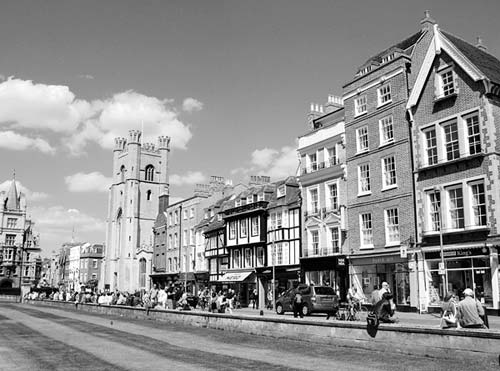
Looming across the street from the Senate House is Great St. Mary’s Church (a.k.a. the University Church), with a climbable bell tower (£4, Mon-Sat 9:30-16:30, Sun 12:30-16:00, 123 stairs). On the corner nearby is Ryder and Amies (22 King’s Parade), which has been the official university outfitter for 150 years. It’s a great shop for college gear: sweaters, ties, and so on. Upstairs, if you ask, you can try on an undergraduate gown and mortar board.
• Just after the Senate House, take the first left possible (on Senate House passage); at the end, bear left on Trinity Lane to reach the gate where you pay to enter...
Built from 1446 to 1515 by Henrys VI through VIII, England’s best example of Perpendicular Gothic architecture is the single most impressive building in Cambridge.
Cost and Hours: £9, erratic hours depending on school events; during academic term usually Mon-Fri 9:30-15:30, Sat 9:30-15:15, Sun 13:15-14:30; during breaks (see here ) usually daily 9:30-16:30; recorded info tel. 01223/331-1212.
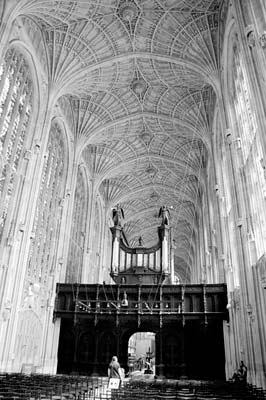
Evensong: When school’s in session, you’re welcome to enjoy an evensong service in this glorious space, with a famous choir made up of men and boys (free, Mon-Sat at 17:30, Sun at 15:30; for more on evensong, see here ). Line up at the front entrance (on King’s Parade) by 17:00 if you want prime seats in the choir.
Visiting the Chapel: Stand inside, look up, and marvel, as Christopher Wren did, at what was then the largest single span of vaulted roof anywhere. Built between 1512 and 1515, its 2,000 tons of incredible fan vaulting—held in place by the force of gravity—are a careful balancing act resting delicately on the buttresses visible outside the building.
While Henry VI—who began work on the chapel—wanted it to be austere, his descendants decided it should glorify the House of Tudor (of which his distant relative, Henry VII, was the first king). Lining the walls are giant Tudor coats-of-arms. The shield is supported by symbolism for each branch of the family: the fleur-de-lis because an earlier ancestor, Edward III, woke up one day and somewhat arbitrarily declared himself king of France; a rose and the dragon of Wales represent the family of Henry VII’s father; and the greyhound holding the shield and the portcullis (the iron grate) symbolize the family of Henry VII’s mother, Lady Margaret Beaufort.
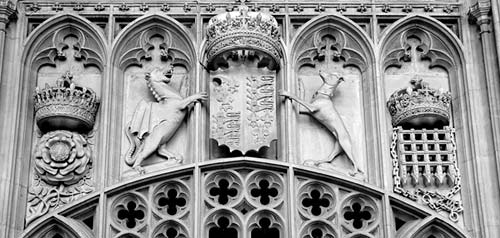
The 26 stained-glass windows date from the 16th century. It’s the most Renaissance stained glass anywhere in one spot. (Most of the stained glass in English churches dates from Victorian times, but this glass is three centuries older.) The lower panes show scenes from the New Testament, while the upper panes feature corresponding stories from the Old Testament. Considering England’s turbulent history, it’s miraculous that these windows have survived for nearly half a millennium in such a pristine state. After Henry VIII separated from the Catholic Church in 1534, many such windows and other Catholic features around England were destroyed. (Think of all those ruined abbeys dotting the English countryside.) However, since Henry had just paid for these windows, he couldn’t bear to destroy them. A century later, in the days of Oliver Cromwell, another wave of iconoclasm destroyed more windows around England. Though these windows were slated for removal, they stayed put. (Historians speculate that Cromwell’s troops, who were garrisoned in this building, didn’t want the windows removed in the chilly wintertime.) Finally, during World War II, the windows were taken out and hidden away for safekeeping, then painstakingly replaced after the war ended. The only nonmedieval windows are on the west wall (opposite the altar). These are in the Romantic style from the 1880s; when Nazi bombs threatened the church, all agreed they should be left in place.
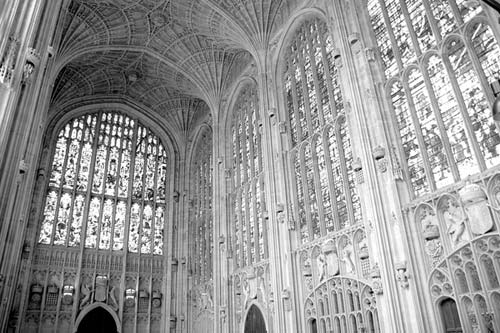
The choir screen that bisects the church was commissioned by King Henry VIII to commemorate his marriage to Anne Boleyn. By the time it was finished, so was she (beheaded). But it was too late to remove her initials, which were carved into the screen (look on the far left and right for R.A., for Regina Anna —“Queen Anne”). Behind the screen is the choir area, where the King’s College Choir performs a daily evensong (during school terms). On Christmas Eve, a special service is held here and broadcast around the world on the BBC—a tradition near and dear to British hearts.
Walk to the altar and admire Rubens’ masterful Adoration of the Magi (1634). It’s actually a family portrait: The admirer in the front (wearing red) is a self-portrait of Rubens, Mary looks an awful lot like his much-younger wife, and the Baby Jesus resembles their own newborn at the time. The chapel to the right of the altar is a moving memorial to those who died in the World Wars.
Finally, check out the long and fascinating series of rooms that run the length of the nave on the left. Dedicated to the history and art of the church, these are a great little King’s College Chapel museum (including a model showing how the fan vaults were constructed).
• Exit the church opposite where you entered, into the college court. From here you can stroll the rich grounds all the way to the River Cam and then back, passing through the grand entry gate and onto King’s Parade.
My self-guided walk takes you to most of the main sights in Cambridge, but not all. Your time is well spent visiting these places as well.
More than a third of Cambridge’s 83 Nobel Prize winners have come from this richest and biggest of the town’s colleges, founded in 1546 by Henry VIII. The college has three sights to see: the entrance gate, the grounds, and the magnificent Wren Library.
Cost and Hours: Grounds—£3, daily 10:00-17:00; library—free, Mon-Fri 12:00-14:00, during full term also Sat 10:30-12:30, closed Sun year-round; only 20 people allowed in at a time, tel. 01223/338-400, www.trin.cam.ac.uk .
Visiting the College: To see the Wren Library without paying for the grounds, access it from the riverside entrance (a long walk around the college via the Garret Hostel Bridge).
Trinity Gate: You’ll notice gates like these adorning facades of colleges around town. Above the door is a statue of King Henry VIII, who founded Trinity because he feared that Cambridge’s existing colleges were too cozy with the Church. Notice Henry’s right hand holding a chair leg instead of the traditional scepter with the crown jewels. This is courtesy of Cambridge’s Night Climbers, who first replaced the scepter a century ago, and continue to periodically switch it out for other items. According to campus legend, decades ago some of the world’s most talented mountaineers enrolled at Cambridge...in one of the flattest parts of England. (Cambridge was actually a seaport until Dutch engineers drained the surrounding swamps.) Lacking opportunities to practice their skill, they began scaling the frilly facades of Cambridge’s college buildings under cover of darkness (if caught, they’d have been expelled). In the 1960s, climbers actually managed to haul an entire automobile onto the roof of the Senate House. The university had to bring in the army to cut it into pieces and remove it. Only 50 years later, at a class reunion, did the guilty parties finally fess up.
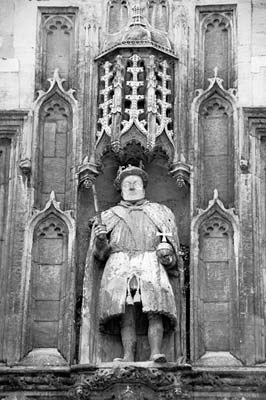
In the little park to the right, notice the lone apple tree. Supposedly, this tree is a descendant of the very one that once stood in the garden of Sir Isaac Newton (who spent 30 years at Trinity). According to legend, Newton was inspired to investigate gravity when an apple fell from the tree onto his head. This tree stopped bearing fruit long ago; if you do see apples, they’ve been tied on by mischievous students.
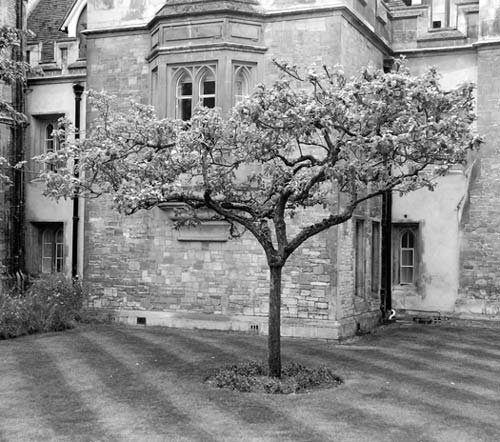
Beyond the gate are the Trinity grounds. Note that there’s often a fine and free view of Trinity College courtyard—if the gate is open—from Trinity Lane (leading, under a uniform row of old chimneys, around the school to the Wren Library).
Trinity Grounds: The grounds are enjoyable to explore. Inside the Great Court, the clock (on the tower on the right) double-rings at the top of each hour. It’s a college tradition to take off running from the clock when the high noon bells begin (it takes 43 seconds to clang 24 times), race around the courtyard, touching each of the four corners without setting foot on the cobbles, and try to return to the same spot before the ringing ends. Supposedly only one student (a young lord) ever managed the feat—a scene featured in Chariots of Fire (but filmed elsewhere).
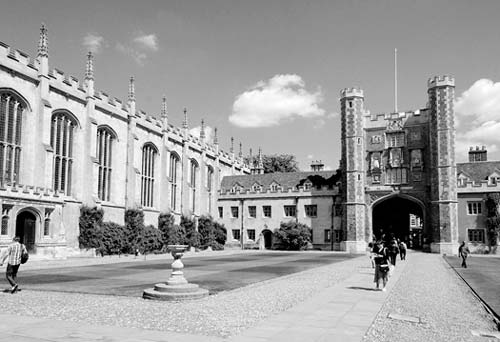
The chapel (entrance to the right of the clock tower)—which pales in comparison to the stunning King’s College Chapel—feels like a shrine to thinking, with statues honoring great Trinity minds both familiar (Isaac Newton, Alfred, Lord Tennyson, Francis Bacon) and unfamiliar. Who’s missing? The poet Lord Byron, who was such a hell-raiser during his time at Trinity that a statue of him was deemed unfit for Church property; his statue stands in the library instead.
Wren Library: Don’t miss the 1695 Christopher Wren-designed library, with its wonderful carving and fascinating original manuscripts. Just outside the library entrance, Sir Isaac Newton clapped his hands and timed the echo to measure the speed of sound as it raced down the side of the cloister and back. In the library’s 12 display cases (covered with cloth that you flip back), you’ll see handwritten works by Sir Isaac Newton and John Milton, alongside A. A. Milne’s original Winnie the Pooh (the real Christopher Robin attended Trinity College). Unlike the other libraries at Cambridge, Wren designed his to be used from the first floor up—instead of the damp, dark ground floor. As a result, Wren’s library is flooded with light, rather than water (and it’s also brimming with students during exam times).
Britain’s best museum of antiquities and art outside London is the Fitzwilliam. Housed in a grand Neoclassical building, a 10-minute walk south of Market Square, it’s a palatial celebration of beauty and humankind’s ability to create it.
Cost and Hours: Free but £5 donation suggested, Tue-Sat 10:00-17:00, Sun 12:00-17:00, closed Mon, photos allowed without flash, lockers, Trumpington Street, tel. 01223/332-900, www.fitzmuseum.cam.ac.uk .
Visiting the Museum: The Fitzwilliam’s broad collection is like a mini-British Museum/National Gallery rolled into one; you’re bound to find something you like. Helpful docents—many with degrees or doctorates in art history—are more than willing to answer questions about the collection. The ground floor features an extensive range of antiquities and applied arts—everything from Greek vases, Mesopotamian artifacts, and Egyptian sarcophagi to Roman statues, fine porcelain, and suits of armor.
Upstairs is the painting gallery, with works that span art history: Italian Venetian masters (such as Titian and Canaletto), a worthy English section (featuring Gainsborough, Reynolds, Hogarth, and others), and a notable array of French Impressionist art (including Monet, Renoir, Pissarro, Degas, and Sisley). Rounding out the collection are old manuscripts, including some musical compositions from Handel.
Although this museum contains no originals, it offers a unique chance to study accurate copies (19th-century casts) of virtually every famous ancient Greek and Roman statue. More than 450 statues are on display. If you’ve seen the real things in Greece, Istanbul, Rome, and elsewhere, touring this collection is like a high school reunion...“Hey, I know you!” But since it takes some time to get here, this museum is best left to devotees of classical sculpture.
Cost and Hours: Free, Mon-Fri 10:00-17:00, Sat 10:00-13:00 during term, closed Sun year-round, Sidgwick Avenue, tel. 01223/330-402, www.classics.cam.ac.uk/museum .
Getting There: The museum is a five-minute walk west of Silver Street Bridge; after crossing the bridge, continue straight until you reach a sign reading Sidgwick Site.
For a little levity and probably more exercise than you really want, try renting one of the traditional flat-bottom punts at the river and pole yourself up and down (or around and around, more likely) the lazy Cam. This is one of the best memories the town has to offer, and once you get the hang of it, it’s a fine way to enjoy the scenic side of Cambridge. It’s less crowded in late afternoon (and less embarrassing).
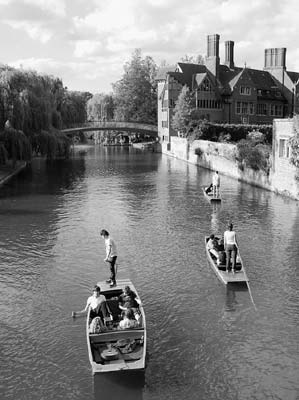
Several companies rent punts and also offer punting tours with entertaining narration. Hawkers try to snare passengers in the thriving people zone in front of King’s College. Prices are soft in slow times—try talking them down a bit before committing.
Scudamore’s has two locations: on Mill Lane, just south of the central Silver Street Bridge, and at the less convenient Quayside at Magdalene Bridge, at the north end of town (£27.50/hour, credit-card deposit required; 45-minute tours-£19/person, ask for discount; open daily 9:00-dusk, tel. 01223/359-750, www.scudamores.com ).
Cambridge Chauffeur Punts, just under the Silver Street Bridge, also rents punts. Take yourself and up to five friends for a spin, or they will chauffeur (£24/hour; passport, credit card, or £60 cash deposit required; 45-minute shared tours-£15/person; open daily March-Nov 9:00-dusk, tel. 01223/354-164, www.punting-in-cambridge.co.uk ).
This former airfield, nine miles south of Cambridge, is popular with aviation fans and WWII history buffs. Wander through seven exhibition halls—including the newly reopened American Air wing—housing 200 vintage aircraft (including Spitfires, B-17 Flying Fortresses, a Concorde, and a Blackbird) as well as military land vehicles and special displays on Normandy and the Battle of Britain. On many weekends, the museum holds special events, such as air shows (extra fee)—check the website for details.
Cost and Hours: £18, show local bus ticket for discount, daily 10:00-18:00, off-season until 16:00, last entry one hour before closing; tel. 01223/835-000, www.iwm.org.uk/visits/iwm-duxford .
Getting There: The museum is located off the A-505 in Duxford. On Sundays, direct Myalls bus #132 runs to the museum from the train station (4/day, 30 minutes, www.travelineeastanglia.org.uk ). On other days of the week, it’s best to take a taxi from Cambridge. (Other buses do stop in Duxford, but too far from the museum to walk.)
While Cambridge is an easy side-trip from London (and you can enjoy an evening here before catching a late train back), its subtle charms might convince you to spend a night or two. Cambridge has few accommodations in the city center, and none in the tight maze of colleges and shops where you’ll spend most of your time. These recommendations (each just past the Fitzwilliam Museum) are about a 10-minute walk south of the town center, toward the train station. (Though weak in hotel offerings, Cambridge does have plenty of B&Bs, which you can research and book online.)
$$$ Lensfield Hotel, popular with visiting professors, has 40 comfortable, old-fashioned rooms (spa and fitness room, 53 Lensfield Road, tel. 01223/355-017, www.lensfieldhotel.co.uk , enquiries@lensfieldhotel.co.uk ).
$$$ Hotel du Vin is a pretentious place that rents 41 decent rooms at a high price. It has duck-your-head character and a good location (breakfast extra, Trumpington Street 15, tel. 01223/227-330 or 0844-736-4253, www.hotelduvin.com , reception.cambridge@hotelduvin.com ).
(See "Cambridge" map, here .)
$$$ The Eagle, near the TI and described earlier in my town walk, is the oldest pub in town. While the food is mediocre, the pub is a Cambridge institution with a history so rich that a visit here practically qualifies as sightseeing (food served daily 11:00-22:00, 8 Benet Street, tel. 01223/505-020).
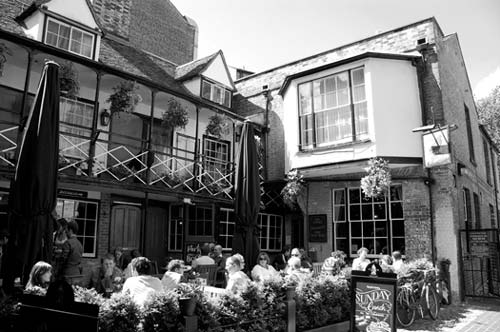
$ Michaelhouse Café is a heavenly respite from the crowds, tucked into the repurposed St. Michael’s Church, just north of Great St. Mary’s Church. At lunch, choose from salads and sandwiches, as well as a few hot dishes and a variety of tasty baked goods (Mon-Sat 8:00-17:00, breakfast served 8:00-11:30, lunch served 11:30-15:50, closed Sun, Trinity Street, tel. 01223/309-147). Between 15:00 and 17:00 whatever they have left from lunch is half-price.
$$$ The Anchor Pub ’s claim to fame is as the setting of Pink Floyd’s first gig. Today it’s known for the best people-watching—and some locals say best food—in Cambridge. Choose from its outdoor riverside terrace, inside bar, or more romantic upstairs restaurant (all seating areas serve the same menu, but the upstairs menu has a few added specials; daily 12:00-21:30, on the riverfront at Silver Street, tel. 01224/353-554).
$ Bread & Meat serves simple soups and hearty sandwiches. Grab a signature porchetta sandwich to take away or snag a rustic table in the small dining room (Sun-Thu 11:00-19:30, Fri-Sat 10:00-21:00, 4 Benet Street, tel. 0791/808-3057).
$$ Agora at The Copper Kettle is a popular place for Greek and Turkish meze, beautifully situated facing King’s College on King’s Parade (also fish-and-chips at lunch, daily 8:00-20:30, later in summer, 4 King’s Parade, tel. 01223/308-448).
$$ Fitzbillies, long a favorite for cakes (Chelsea Buns) and coffee, offers inviting lunch and afternoon tea menus (daily, 51 Trumpington Street, tel. 01223/352-500).
$ Fast Food: For healthy fast-food chains, the corner of Petty Curry Lane and Sidney Street (a long block off Market Hill Square) has three good places: Eat, Pret, and Wasabi.
Supermarkets: There’s a Marks & Spencer Simply Food at the train station (Mon-Sat 7:00-23:00, Sun 9:00-23:00) and a larger Marks & Spencer department store on Market Hill Square (Mon-Tue 8:00-18:00, later Wed-Sat, Sun 11:00-17:00). Sainsbury’s supermarket has longer hours (Mon-Sat 7:30-23:30, Sun 11:00-17:00, 44 Sidney Street, at the corner of Green Street).
A good picnic spot is Laundress Green, a grassy park on the river, at the end of Mill Lane near the Silver Street Bridge punts. There are no benches, so bring something to sit on. Remember, the college lawns are private property, so walking or picnicking on the grass is generally not allowed. When in doubt, ask at the college’s entrance.
From Cambridge by Train to: York (hourly, 2.5 hours, transfer in Peterborough), Oxford (2-3/hour, 2.5-3 hours, change in London involves Tube transfer between train stations), London (King’s Cross Station: 2/hour, 45 minutes; Liverpool Street Station: 2/hour, 1.5 hours). Train info: Tel. 0345-748-4950, www.nationalrail.co.uk .
By Bus to: London (every 60-90 minutes, 2 hours), Heathrow Airport (1-2/hour, 2-3 hours), Oxford (2/hour, 3.5 hours). Bus info: Tel. 0871-781-8181, www.nationalexpress.com .
As old as the pyramids, and older than the Acropolis and the Colosseum, this iconic stone circle amazed medieval Europeans, who figured it was built by a race of giants. And it still impresses visitors today. As one of Europe’s most famous sights, Stonehenge, worth ▲▲ , does a valiant job of retaining an air of mystery and majesty (partly because cordons, which keep hordes of tourists from trampling all over it, foster the illusion that it stands alone in a field). Although some people are underwhelmed by Stonehenge, most of its almost one million annual visitors find that it’s worth the trip. And the ancient site continues to reveal its mysteries: In 2010, within sight of Stonehenge, archaeologists discovered another 5,000-year-old henge, which they believe once encircled a wooden “twin” of the famous circle. Recent excavations revealed that people had been living on the site since around 3,000 B.C. —about five centuries earlier than anyone had realized.
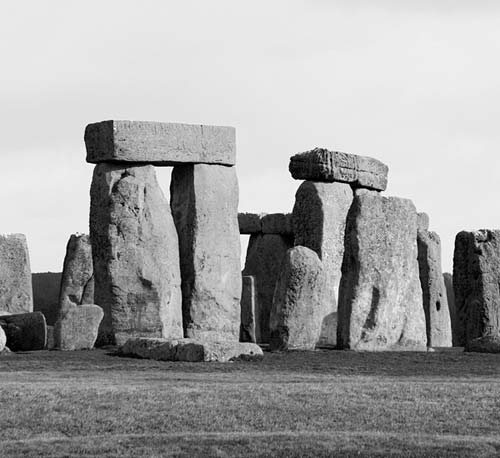
Stonehenge is about 90 miles southwest of central London. To reach it from London, you can take a bus tour; go on a guided tour that uses public transportation; or do it on your own using public transit, connecting via Salisbury. It’s not worth the hassle or expense to rent a car just for a Stonehenge day trip.
By Bus Tour from London: Several companies offer big-bus day trips to Stonehenge from London, often with stops in Bath, Windsor, Salisbury, and/or Avebury. These generally cost about £45-85 (including admission to Stonehenge), last 8-12 hours, and pack a 45-seat bus. Some include hotel pickup, admission fees, and meals; all of the companies listed below also offer tours of the inner circle for about twice the cost of the basic Stonehenge package—understand what’s included before you book. The more destinations listed for a tour, the less time you’ll have at any one stop. Well-known companies are Evan Evans (their bare-bones Stonehenge Express gets you there and back for £45, tel. 020/7950-1777 or US tel. 866-382-6868, www.evanevanstours.com ) and Golden Tours (£58-60, tel. 020/7630-2028 or US toll-free tel. 800-509-2507, www.goldentours.com ). International Friends runs pricier but smaller 16-person tours that include Windsor and Bath (£119, tel. 01223/244-555, www.internationalfriends.co.uk ).
By Guided Tour on Public Transport: London Walks offers a guided “Stonehenge and Salisbury Tour” by train and bus on Tuesdays from May through October (£60, includes all transportation, Salisbury walking tour, entry fees, and guided tours of Stonehenge and Salisbury Cathedral; buy all tickets from guide; cash only, Tue at 8:45, meet at Waterloo Station’s main ticket office, opposite Platform 16, verify price and schedule by phone or online, advance booking not required, tel. 020/7624-3978, recorded info tel. 020/7624-9255, www.walks.com ).
On Your Own on Public Transport: You can catch a train to Salisbury, then go by bus or taxi to Stonehenge. Trains to Salisbury run from London’s Waterloo Station (around £39 for same-day return leaving weekdays after 9:30, 2/hour, 1.5 hours, tel. 0871-200-4950 or 0345-748-4950, www.southwesttrains.co.uk or www.nationalrail.co.uk ).
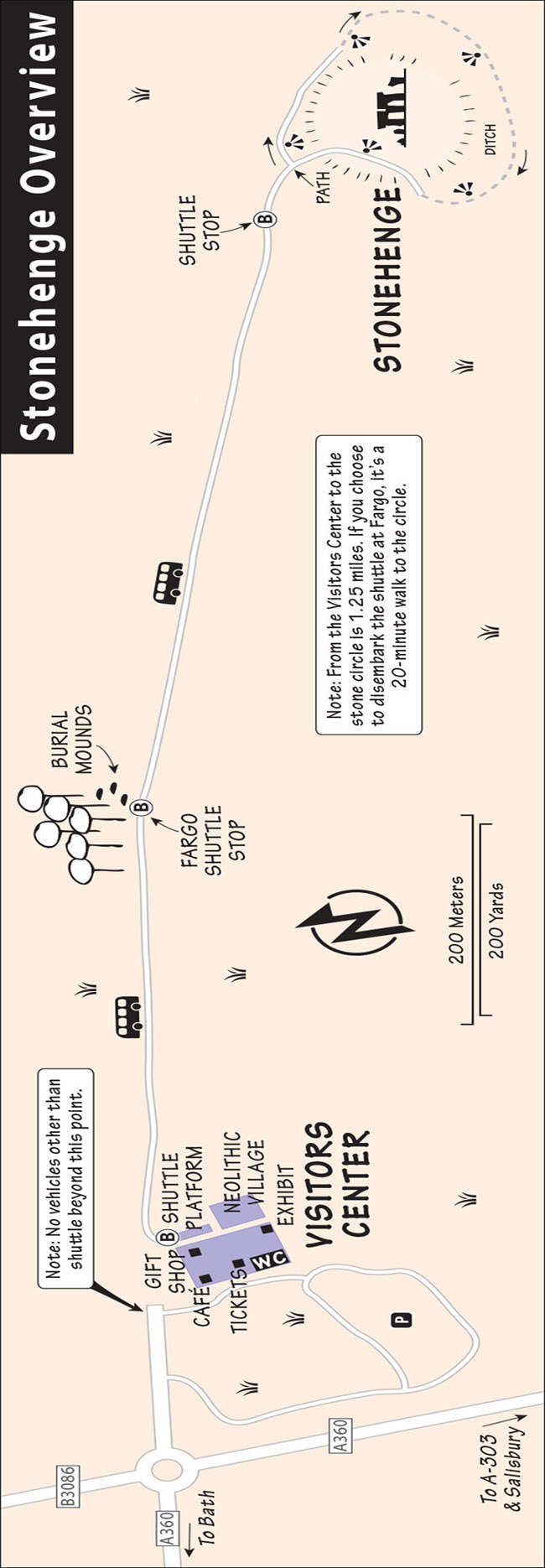
Once in Salisbury, you can take The Stonehenge Tour bus to the site. Their distinctive double-decker buses leave from the Salisbury train station (also stops at bus station) and make a circuit to Stonehenge and Old Sarum, with lovely scenery and a decent light commentary along the way (£14, £27 with Stonehenge and Old Sarum admission; tickets good all day; buy ticket from driver; daily June-Aug 10:00-18:00, 2/hour; may not run June 21 because of solstice crowds, shorter hours and hourly departures off-season; 30 minutes from station to Stonehenge, tel. 01202/338-420, timetable at www.thestonehengetour.info ).
A taxi from Salisbury to Stonehenge can make sense for groups (about £40-50). Try Value Cars Taxis (tel. 01722/505-050, www.salisbury-valuecars.co.uk ) or a local cabbie named Brian (tel. 01722/339-781, briantwort@ntlworld.com ).
Cost: £17.10, buy in advance online (see next), covered by English Heritage Pass (see here ), includes shuttle-bus ride to the stone circle. In summer, there’s a £5 refundable parking fee for drivers.
Advance Tickets: Prebooking a timed-entry ticket at least 24 hours in advance is the only way to assure you’ll actually get in to the site, which caps the number of visitors per day at 7,000. (Some same-day tickets may be available at the ticket window, but in high season, it’s risky to count on this.) Purchase your ticket online at www.english-heritage.org.uk/stonehenge . After booking a 30-minute arrival window, you’ll receive a confirmation email with your e-ticket. Either print your ticket to present at the site, or bring your booking reference number with you.
If tickets are sold out for the day you planned to visit, consider a guided tour that includes entry (see various options under “Getting to Stonehenge,” earlier).
Hours: Daily June-Aug 9:00-20:00, mid-March-May and Sept-mid-Oct 9:30-19:00, mid-Oct-mid-March 9:30-17:00. Note that last entry is two hours before closing. Expect shorter hours and possible closures June 20-22 due to huge, raucous solstice crowds.
Information: Tel. 0870-333-1181, www.english-heritage.org.uk/stonehenge .
Tours: Audioguides are available behind the ticket counter (included with Heritage Pass, otherwise £2); the same audio content can be downloaded for free to your mobile device from the English Heritage website using the visitors center’s free Wi-Fi (download before boarding the shuttle bus).
Visiting the Inner Stones: For the true Stonehenge fan, special one-hour access to the stones’ inner circle is available early in the morning (times vary depending on sunrise, but the earliest is 5:00 in June and July) or after closing to the general public. Touching the stones is not allowed. Only 26 people are allowed at a time, so reservations must be made well in advance (£31.80, allows you to revisit the site the same day at no extra charge). Details are on the website (choose “Stone Circle Access Visits” from the “Plan Your Visit” drop-down menu). You can also pay more to visit the inner circle with a private tour company.
Services: The visitors center has WCs, a large gift shop, and free Wi-Fi. Services at the circle itself are limited to emergency WCs. Even in summer, carry a jacket, as there are no trees to act as a wind-break and there’s a reason the Salisbury plains are so green.
Eating: A large $ café within the visitors center serves hot drinks, soups, sandwiches, and salads along with hot light bites.
Length of this Tour: Allow at least two hours to see everything.
 SELF-GUIDED TOUR
SELF-GUIDED TOUR
(See "Stonehenge" map, here .)
Whether you’re using the audioguide or downloading the audio tour to your mobile device, this commentary will help make your visit even more meaningful. Start by touring the visitors center, then take a shuttle (or walk) to the stone circle.
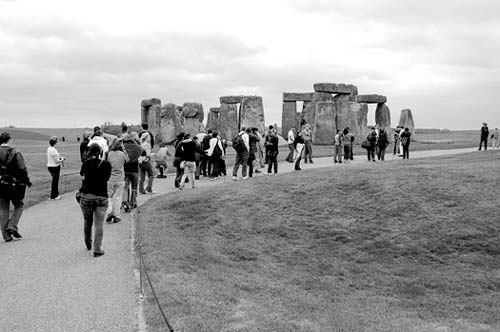
• Collect your ticket (and rent or download the audioguide) before heading to the excellent exhibit space.
The visitors center, located 1.25 miles west of the circle, is a minimalist steel structure with a subtly curved roofline, intended to replicate the Salisbury plains.
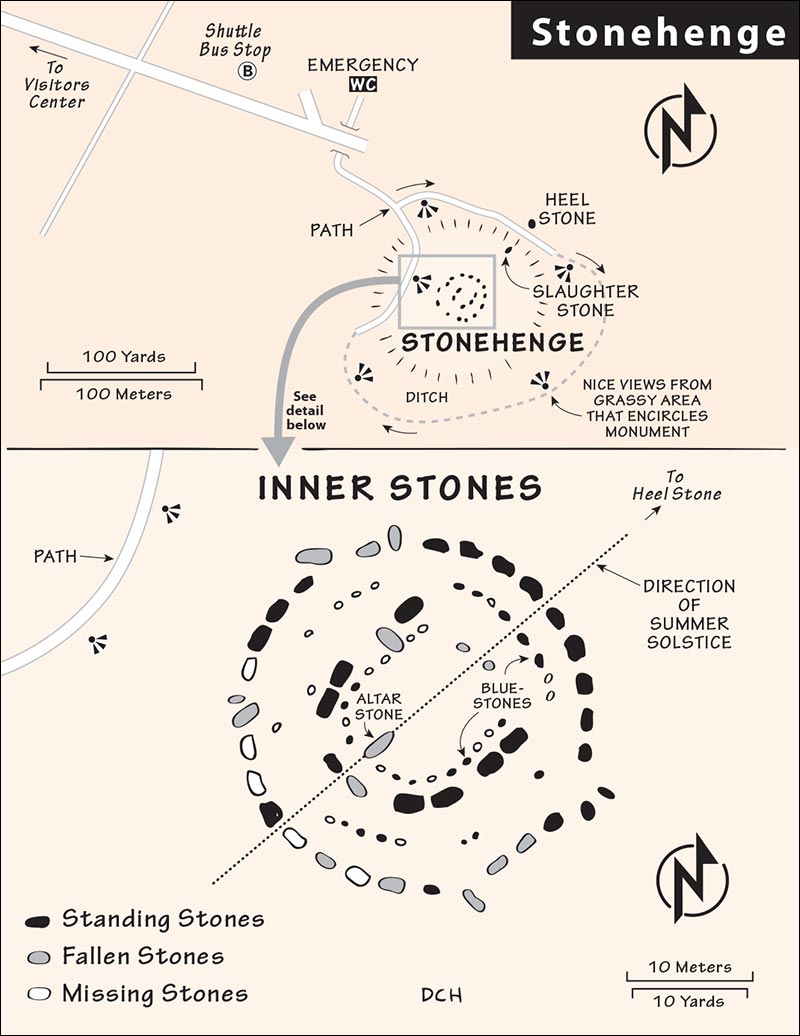
The permanent exhibit uses an artful combination of high-tech multimedia displays and prehistoric bones, tools, and pottery shards to explore the history of the people who built Stonehenge, how they lived, and why they might have built the stone circle.
Stand in the virtual center of Stonehenge as 5,000 years pass by around you. Find the forensic reconstruction of a Neolithic man based on a skeleton unearthed in 1863. Then step outside and visit his ancient neighborhood—a village of Neolithic huts modeled after the traces of a village discovered just northeast of Stonehenge.
If nature calls, be sure to use the WCs within the visitors center, as there are only emergency WCs at the circle itself—and your lack of planning will likely not qualify as an emergency.
• Shuttle buses to the stone circle depart every 5-10 minutes from the platform behind the gift shop. The trip takes six minutes. If you’d prefer, you can walk 1.25 miles through the fields to the site (use the map you receive with your ticket, or ask a staff member for directions).
Along the way, you have the option of stopping at Fargo Plantation, where you can see several burial mounds (tell the shuttle attendant if you want to disembark here). After wandering through the burial mounds, you’ll need to walk the rest of the way to the stone circle (about 20 minutes).
As you approach the massive structure, walk right up to the knee-high cordon and let your fellow 21st-century tourists melt away. It’s just you and the druids...
England has hundreds of stone circles, but Stonehenge—which literally means “hanging stones”—is unique. It’s the only one that has horizontal cross-pieces (called lintels) spanning the vertical monoliths, and the only one with stones that have been made smooth and uniform. What you see here is a bit more than half the original structure—the rest was quarried centuries ago for other buildings.
Now do a slow clockwise spin around the monument, and ponder the following points. As you walk, mentally flesh out the missing pieces and re-erect the rubble. Knowledgeable guides posted around the site are happy to answer your questions.
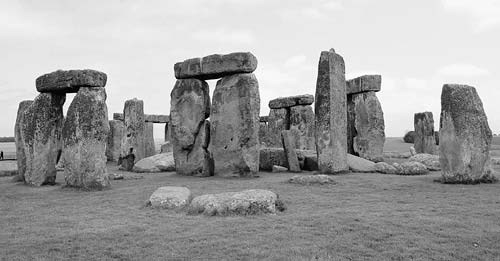
It’s now believed that Stonehenge, which was built in phases between 3000 and 1500 B.C. , was originally used as a cremation cemetery. But that’s not the end of the story, as the monument was expanded over the millennia. This was a hugely significant location to prehistoric peoples. There are several hundred burial mounds within a three-mile radius of Stonehenge—some likely belonging to kings or chieftains. Some of the human remains are of people from far away, and others show signs of injuries—evidence that Stonehenge may have been used as a place of medicine or healing.
Whatever its original purpose, Stonehenge still functions as a celestial calendar. As the sun rises on the summer solstice (June 21), the “heel stone” —the one set apart from the rest, near the road—lines up with the sun and the altar at the center of the stone circle. A study of more than 300 similar circles in Britain found that each was designed to calculate the movement of the sun, moon, and stars, and to predict eclipses in order to help early societies know when to plant, harvest, and party. Even in modern times, as the summer solstice sun sets in just the right slot at Stonehenge, pagans boogie.
Some believe that Stonehenge is built at the precise point where six “ley lines” intersect. Ley lines are theoretical lines of magnetic or spiritual power that crisscross the globe. Belief in the power of these lines has gone in and out of fashion over time. They are believed to have been very important to prehistoric peoples, but then were largely ignored until the early 20th century, when the English writer Alfred Watkins popularized them (to the scorn of serious scientists). More recently, the concept has been embraced by the New Age movement. Without realizing it, you follow these ley lines all the time: Many of England’s modern highways, following prehistoric paths, and churches, built over prehistoric monuments, are located where ley lines intersect. If you’re a skeptic, ask one of the guides at Stonehenge to explain the mystique of this paranormal tradition that continued for centuries; it’s creepy and convincing.
Notice that two of the stones (facing the entry passageway) are blemished. At the base of one monolith, it looks like someone has pulled back the stone to reveal a concrete skeleton. This is a clumsy repair job to fix damage done long ago by souvenir seekers, who actually rented hammers and chisels to take home a piece of Stonehenge. Look to the right of the repaired stone: The back of another stone is missing the same thin layer of protective lichen that covers the others. The lichen—and some of the stone itself—was sandblasted off to remove graffiti. (No wonder they’ve got Stonehenge roped off now.) The repairs were intentionally done in a different color, so as not to appear like the original stone.
Stonehenge’s builders used two different types of stone. The tall, stout monoliths and lintels are sandstone blocks called sarsen stones. Most of the monoliths weigh about 25 tons (the largest is 45 tons), and the lintels are about 7 tons apiece. These sarsen stones were brought from “only” 20 miles away. The shorter stones in the middle, called bluestones, came from the south coast of Wales—240 miles away (close if you’re taking a train, but far if you’re packing a megalith). Imagine the logistical puzzle of floating six-ton stones across Wales’ Severn Estuary and up the River Avon, then rolling them on logs about 20 miles to this position...an impressive feat, even in our era of skyscrapers. We know the stones came from Wales because geologists have chemically matched the bluestones to specific outcrops there.
Why didn’t the builders of Stonehenge use what seem like perfectly adequate stones nearby? This, like many other questions about Stonehenge, remains shrouded in mystery. Think again about the ley lines. Ponder the fact that many experts accept none of the explanations of how these giant stones were transported. Then imagine congregations gathering here 5,000 years ago, raising thought levels, creating a powerful life force transmitted along the ley lines. Maybe a particular kind of stone was essential for maximum energy transmission. Maybe the stones were levitated here. Maybe psychics really do create powerful vibes. Maybe not. It’s as unbelievable as electricity used to be.